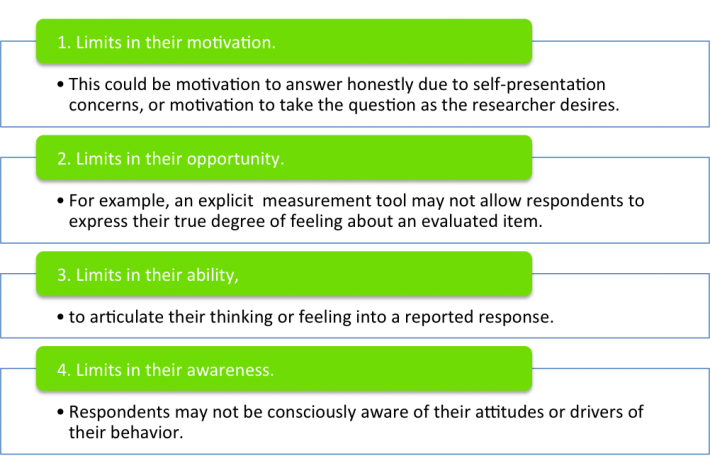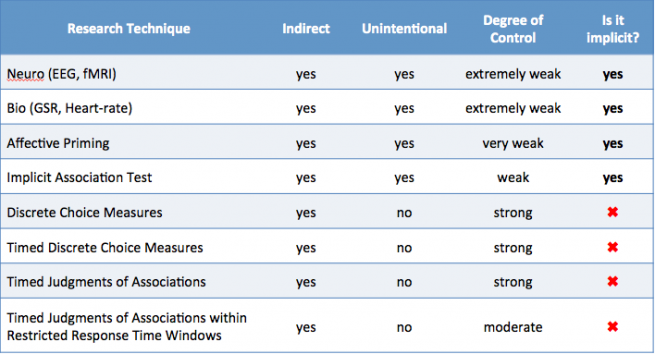Is it Implicit? Implicit vs Explicit Techniques in Consumer Insights Research
I can hear Cher’s beautiful bellow on the remake version now…“if you want to know, if he loves you so, it’s in his kiss…whoa, yeah, it’s in his kiss!”
Try to ignore the catchy tune that just lodged itself into your subconscious and think about the human truth in that lyric for a moment. When you really want to know how someone feels do you find it in their words or in their actions?
As a psychologist, it is hard for me to understand how market research has survived as long as it has with such great reliance on explicitly stated answers to survey questions for insight into the drivers of behavior.
If it were as easy as asking people why they do what they do, why would behavioral science fields like psychology, neuroscience, cultural anthropology and behavioral economics even exist?
As a business executive, it is easy for me to understand why market research has thrived despite its reliance on explicitly stated answers to survey questions. The pace of business demands answers now, and we must use the best tools at our disposal to get data that can inform our decisions.
For decades, the best quantitative tools available were based on explicitly stated answers to survey questions, so that is what we used.
Implicit Research Technologies Tell the Stories Consumers Won’t
Fortunately, with the merger of behavioral science and business, the best quantitative tools just got better. The rise of implicit research technology has given researchers ways to gain consumer insights without relying solely on what consumers are able and willing to self-report (in market research we call that the “can’t say (unable) won’t say (unwilling)” issue).
Many progressive insights divisions are well aware of the can’t say/won’t say issue and are actively putting advanced quantitative implicit techniques into practice to get around it.
For the purposes of calculating current penetration of these techniques, I am classifying neurological, physiological, priming with response time and implicit association test (IAT) measurement techniques as implicit research technologies (more on the definition below).
If we use the Winter 2013 GRIT report as a rough guide of usage estimates, and if we put a hefty 50% discount on the percentages to account for some selection bias in the GRIT sample, neuromarketing seems to come in around five percent penetration (.1 x .5=.05), biometrics comes in around four percent (.08 x .5=.04) and priming and response time/IAT methods aren’t broken out on the list.
Thus, we estimate that implicit research technologies are still in the early adoption phase in the industry, meaning on a market research product adoption curve less than 16% of all businesses are putting these techniques into practice.
This is promising for providers who are practicing techniques that fit the implicit research technology definition. It indicates that there is potential for major growth ahead, and even as competition stiffens, one might expect all boats to rise with the tide.
And yet, for insights managers, the early adoption phase can be a scary place to be practicing. There are a lot of questions that still need good standard industry answers, including:
- What should you use to evaluate the quality of a potential provider of implicit research?
- What are the appropriate use cases of implicit research technology?
- Should implicit techniques be combined with traditional techniques, including when and how?
- What qualifies as an implicit research technique to begin with?
The primary goal here is to answer the last question by defining what counts as a truly implicit research technique. Fortunately, the behavioral science literature has beaten us to the punch, and so the answer is readily available to be applied.
Nosek, Hawkins and Frazier (2011) provide a definition and add value by detailing the conditions where implicit research techniques are able to unearth different insights than traditional measures. The authors provide evidence that insights from explicit techniques are limited, when people have:

Nosek et al. argue that implicit research technologies are able to account for each of the above “can’t say/won’t say” limitations*. The authors then provide a broad definition of implicit techniques as those that are NOT “direct, deliberate, controlled, intentional self-assessments”**.
This definition provides market research with useful criteria for evaluating whether a measure is implicit or not. However, it is important to note that even within the implicit literature authors are making arguments around the “strength of implicitness” in a measure (De Houwer et al. (2009)), indicating that there is not currently a pure implicit measurement, but rather there are degrees of “implicitness” in measures.
For example, bio-measures, such as galvanic skin response (GSR; i.e. the degree to which your skin is producing moisture), are partially controllable given the right conditions (e.g. motivation, awareness and practice)***. Thus, GSR while appropriately characterized as implicit, is not purely implicit in the strictest definition of the term.
The same is true for some of the better known behavioral response time based implicit measures, including the venerable IAT. In fact, De Houwer et. al (2009) argue that…
the available evidence does not allow for the strong conclusion that IAT effects are implicit in the sense of being always independent of the goals to avoid or alter the expression of the to-be-measured attribute. Nevertheless, it does seem to be the case that IAT effects are more difficult to control than are most traditional (questionnaire) measures.
The idea of degree of controllability is very useful in evaluating how good a measure is at capturing implicit insight. If we create a simple table and evaluate techniques along the broad dimensions forwarded by Nosek et. al (2011) we have a useful tool for assessing the implicitness of a measure.
First, the table provides some very quick insight that indirect does not equal implicit.
For example, discrete choice studies are great indirect measures, that provide derived insight on preferences, however, they are conscious choices on the items being evaluated and therefore do not fit the other implicit criteria.
Second, the table also reveals that a lot of new-to-market techniques that simply measure response times of an evaluation, or solely require quick responses, are not implicit.
For example, having participants very quickly indicate whether an image or word represents some category or experience and timing their response, is an indirect measure. However, it is an indirect measure of their conscious assessment, not an implicit measure of their subconscious (or automatic) association.
These new quick response and pure response time measures are still very valuable, they’re just not implicit measures.
Is it Implicit? Performing Accurate Consumer Insights Research
Defining which measures are implicit versus simply indirect is important because implicit measures are providing researchers with insights into drivers of behavior that explicit measures are not. Consistent evidence shows that implicit measures are accounting for different variance in your consumer behavior of interest than explicit measures (Banaji, et. al.,2004).
This means that Insights Managers want to ensure that the measures are in fact implicit in order to maximize your opportunity for subconscious insights. Otherwise you’re simply adding an additional timed response metric to refine your conscious assessment measures (which again is valuable, it’s just not implicit).
As providers of implicit research we have a lot of work to do as a group to serve the industry and to subsequently benefit from the rising tide of value that these techniques bring to clients.
In that spirit, we have provided a definition for implicit techniques by communicating the great work already completed and peer reviewed in the behavioral science literature. In doing so we hope to have taken a first step in laying the foundation for the discussion of how to build a taxonomy of advanced methods (some implicit and some not) including when, why and how to best use these techniques.
Now if I could just get that image of Cher and that dang “it’s in his kiss” song out of my head! I’m definitely willing, but it seems that I’m just not able…
References
Banaji, M, Nosek, B; Greenwald, A (2004). No Place for Nostalgia in Science: A Response to Arkes and Tetlock. Psychological Inquiry, 15(4), 279-310.
De Houwer, J; Teige-Mocigemba, S; Spruyt, A; Moors, A. (2009). Implicit Measures: A normative analysis and review. Psychological Bulletin, 135(3), 347-368.
Nosek, B; Hawkins, C; & Frazier, R (2011). Implicit Social Cognition: From measures to mechanisms. Trends in Cognitive Science, 15(4), 152-159.
* I agree with the authors with one caveat that while implicit techniques may outperform explicit techniques on #2 (i.e. relieving limits in opportunity), implicit techniques can still suffer from limiting opportunity just as any measurement method can.
** De Houwer et al. (2009) offer a much more detailed account of the requirements of an implicit technique which align on the broad characteristics summarized by Nosek et al. (2011). See Sentient’s white paper Measuring the Consumer Subconscious for an accessible summary.
***Given that current evidence of human ability to control neurological and physiological responses through bio-feedback is very limited, it stands to reason that Neuro and Biometric measures are among the best measures on the criterion of “uncontrollable.”


Dear Aaron, well written paper and sound arguments, thank you. But I maintain some doubts, nevertheless. Esplicit research, when feasible, should always be preferred, in my opinion for two strong advantages (a) better understanding of reasons and, yes, motivations; (b) stronger challenges for researchers, because implicit requires a difficult work for proper understanding and interpretation. Two activities that make smarter researchers. Ciao!
Carlo
Thanks Carlo,
I appreciate your comments. It’s probably fair to say that the proper interpretation of what consumers are willing and able to express (explicit answers to questions) is also a challenge for researchers, perhaps even more so, given that a lack of cognitive access to the drivers of behavior and self-presentation biases naturally influence explicit responses.
Even given these challenges, you’ll see in our other writing that we find the best research is that which combines advanced explicit techniques with truly implicit techniques. We need both to get the deepest insight into the drivers of behavior.
Your point on motivations is very important, and it is a good point of distinction for implicit association measures from implicit bio and neuro measures. Implicit association measures offer different levels of explanation on the motivations behind behavior than bio and neuro measures currently.
Thanks for reading and thinking on these important topics – they’re critical for market research advancement.
Pretty! This has been a really wonderful article. Thanks for providing this info.